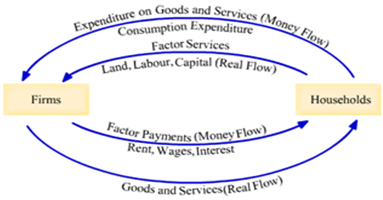 Short Answer Type
Short Answer TypeCalculate “sales” from the following data:
| S.No | Particulars | (Rs in lakhs) |
| (i) | Net Value added at factor cost | 560 |
| (ii) | Depreciation | 60 |
| (iii) | Change in stock | (-) 30 |
| (iv) | Intermediate cost | 1000 |
| (v) | Exports | 200 |
| (vi) | Indirect taxes | 60 |
Giving reasons categorize the following into stock and flow:
(i) Capital
(ii) Saving
(iii) Gross domestic product
(iv) Wealth
Explain the circular flow of income.
The circular flow of income and expenditure refers to the process whereby the national income and expenditure of an economy flow in a circular manner continuously through time.
The various components of national income and expenditure such as saving, investment, taxation, government expenditure, exports, imports, etc. are shown in the form of currents and cross-currents in such a manner that national income equals national expenditure.
Assumptions of the Model:
The circular flow model in a two-sector economy is based on the following assumptions.
1. The economy consists of only two sectors namely, the households and the firms.
2. It is assumed that there is no government sector in the economy, so no taxes and transfer payments.
3. The economy considered is a closed economy i.e. it is assumed that there is no foreign sector. In other words, there is no external trade in the form of imports and exports.
4. The households spend the entire income received on the goods and services. In other words, it is assumed that there is no saving in the economy.
The above diagram depicts a two-sector circular flow model.
The inner arrow in the upper part of the diagram shows that the household sector provides factors services in the form of land, labour and capital to the firms. In return of the factor services provided, they receive factor payments from the firms in the form of rent, wages and interest (as shown by the upper most arrow). With the income received, households incur consumption expenditure on the goods and services provided to them by the firms (as shown by the lower most arrow).
With the help of this circular flow model, we can estimate the national income for the economy. National income can either be measured by aggregating the income of all the factors of production (inner arrow of the lower part) or by aggregating the expenditure incurred by all the sectors (upper most arrow).
Hence in two-sector model, we observe that the aggregate spending of the economy (consumption expenditure) equals the aggregate income earned by the factors of production (factor payments).
 Long Answer Type
Long Answer TypeC = 100 + 0.4 Y is the Consumption Function of an economy where C is Consumption Expenditure and Y is National Income. Investment expenditure is 1,100. Calculate
(i) Equilibrium level of National Income.
(ii) Consumption expenditure at equilibrium level of national income.
Complete the following table:
| Income (Rs) | Consumption expenditure (Rs) | Marginal Propensity to Save | Average Propensity to Save |
| 0 | 80 | ||
| 100 | 140 | 0.4 | - |
| 200 | - | - | 0 |
| - | 240 | - | 0.20 |
| - | 260 | 0.8 | 0.35 |
Calculate National Income from the following data:
| S.No. | Particulars | (Rs in crores) |
| (i) | Private final consumption expenditure | 900 |
| (ii) | Profit | 100 |
| (iii) | Government final consumption expenditure | 400 |
| (iv) | Net indirect taxes | 100 |
| (v) | Gross domestic capital formation | 250 |
| (vi) | Change in stock | 50 |
| (vii) | Net factor income from abroad | (-) 40 |
| (viii) | Consumption of fixed capital | 20 |
| (ix) | Net imports | 30 |
|
S.NO. |
Particulars |
(Rs in Crores) |
|
1
2
3
4
5
6
7
|
Gross domestic product at Market price
Net current transfers to the rest of the world Net indirect tax
Net factor income to abroad
National debt interest
Consumption of fixed capital
Current transfers from government |
2,000
(-)200
150
60
70
200
150 |
